

Original Article - Year 2017 - Volume 32 -
Postoperative quality of life for aesthetic rhinoplasty
Qualidade de vida no pós-operatório de rinoplastia estética
ABSTRACT
INTRODUCTION: As in many cosmetic procedures, assessment of surgical success in rhinoplasty depends on surgeon satisfaction and, mainly, o n patient satisfaction. Nevertheless, there are few studies on the patient's postsurgical point of view. The aim of this study is to evaluate the degree of satisfaction correlated with quality of life in the late post-operative period of patients undergoing rhinoplasty in the Integrated Plastic Surgery Services of the Ipiranga Hospital.
METHODS: Patients undergoing aesthetic rhinoplasty between 2013 and 2014 (n = 60) were selected for the application of two validated questionnaires. All procedures were performed as indicated with the same surgical routine.
RESULTS: Questions 2, 5b, 7, 9a, 9d and 11d of the SF -36 questionnaire showed significant to at least one question of the ROE questionnaire (p < 0.05).
CONCLUSION: Quality of life is related to the degree of satisfaction in the postoperative of cosmetic rhinoplasty in six issues.
Keywords: Aesthetics; Rhinoplasty; Patient satisfaction; Quality of life; Questionnaires.
RESUMO
INTRODUÇÃO: Na rinoplastia, assim como em diversos procedimentos estéticos, a avaliação do sucesso cirúrgico depende da satisfação do cirurgião e, principalmente, da satisfação do paciente. Apesar disso, há escassos estudos sobre o ponto de vista do paciente no período pós-cirúrgico. O objetivo do presente estudo é avaliar o grau de satisfação correlacionando-o com a qualidade de vida no período pós-operatório tardio dos pacientes submetidos à rinoplastia nos Serviços Integrados de Cirurgia Plástica do Hospital Ipiranga.
MÉTODOS: Foram selecionados aleatoriamente (n = 60) pacientes submetidos à rinoplastia estética entre 2013 e 2014 para a aplicação de dois questionários validados. Todos os procedimentos foram realizados conforme a indicação, com a mesma rotina cirúrgica.
RESULTADOS: As questões 2, 5b, 7, 9a, 9d e 11d do questionário SF-36 se mostraram significantes para pelo menos uma questão do questionário ROE (valor p < 0,05).
CONCLUSÃO: A qualidade de vida se relaciona com o grau de satisfação no pós-operatório de rinoplastia estética em seis questões.
Palavras-chave: Estética; Rinoplastia; Satisfação do paciente; Qualidade de vida; Questionários.
Aesthetic rhinoplasty has become a very common surgery in the practice of plastic surgeons. Preoperative discussions are held with patients about their expectations, wishes and surgical goals. Most articles addressing the subject of cosmetic surgery present discussions on surgical techniques, surgical approaches, complications, sequelae, and review rates.
Evaluations of an intervention's final results are hardly ever made from the patient's point of view, and this happens to be a very important analysis because patient satisfaction is the predominant factor of surgical success1,2. Defining the concept of quality of life is still difficult, and no consensus has been achieved on the issue.
We can relate quality of life, for example, with the idea of health, professional achievement, happiness, self-esteem and self-acceptance. In search for a better definition, Medicine no longer considers the disease alone as symptoms control or decreased mortality, but also psychology and aesthetics, often aiming at acceptance of one's own image.
Alsarraf3 developed some questionnaires to assess the results of aesthetic facial procedures from the patient's point of view. In 2000, he created the Rhinoplasty Outcomes Evaluation (ROE), a friendly questionnaire consisting of 6 questions covering the main aspects that influence satisfaction for a patient undergoing rhinoplasty, including the functional and aesthetic aspects of the nose4.
OBJECTIVE
To check the quality of life in patients submitted to aesthetic rhinoplasty for at least one year, using the Short Form-36 (SF-36) questionnaire. To evaluate the degree of patient satisfaction after surgery, using the ROE questionnaire. To examine whether there is any correlation between the ROE and the SF-36 questionnaires.
METHODS
A quantitative study, where 60 patients submitted to cosmetic rhinoplasty were selected from the Plastic Surgery Department of São Paulo's Ipiranga Hospital, in the period June/2013-December/2014. They were invited by telephone to come on a given day and time to the hospital's outpatients clinic to answer the SF-36 and ROE questionnaires.
Patients were excluded when no telephone contact was possible, when they did not agree to provide a Free Informed Consent, and when they did not come for the interview; and patients were also excluded whenever, in addition to rhinoplasty, they were submitted to other procedures associated with the same organ under study (septoplasty, endoscopic surgery, turbinectomies, etc.), amounting to a total of 30.
Each attending patient (n = 30) was presented with the reason for the research, the risks and benefits involved, and the Free Informed Consent to sign. All 30 patients in the study were given the SF-36 (Annex 1) and ROE (Annex 2) questionnaires, and the latter was translated from English to Portuguese by the authors and adapted according to the criteria proposed by Guillemin et al5 to fill out and then return to the researchers.
The data were all processed in Microsoft Excel® and averages and standard deviations were calculated after approval by the Research Ethics Committee of the Ipiranga Hospital (report number: 1.344.954).
For a quantification of post-operative levels of satisfaction and quality of life, patients were submitted to two important validated questionnaires: the ROE and the SF-36. The statistical techniques used to analyze the data were: Profile Analysis and the concept of ANOVA (Analysis of Variance). Profile Analysis: a profile analysis is used to more specifically compare questionnaire results with questionnaires result profiles.
Why is it relevant? Questionnaires are usually administered in Medicine, Psychology and Education studies to classify participants in a study. A profile shows questionnaire score differences. Test results are ordinarily used to predict behavior profiles.
The ANOVA concept is a statistical technique for comparing two or more treatments (or breaks). The main objective of this technique is to check whether there is significant difference between the averages and whether the analyzed factors influence the researcher's variable of interest (response variable). Notations used in the tables and charts herein assume the character (*) to explain when the value is significant at 5%. A variance analysis of the linear regression tests the possibility of a particular hypothesis being rejected.
The estimating vector of the parameters is considered to follow the F test (Fisher-Snedecor), known as Fisher distribution, which is often used in statistical inference for variance analysis. The F test is significant when F is greater than the tabulated value, when the null hypothesis is rejected.
The p-value is calculated for the null hypothesis of the populations that have obtained equal averages, that is, the smallest choice made for the level of significance, in order to reject the null hypothesis. A comparison between the independent groups of variables is measured on the basis of the ANOVA tests to assess differences between two or more variables.
The main objective of this statistical technique is to check whether there is any significant difference between the averages and whether the analyzed factors influence the researcher's variable of interest (response variable).
The Minitab 17 software was used for Null Hypothesis: the average of the classes are equal; Alternative Hypothesis: at least one of the averages is different; and Equal Variances (for the groups) are assumed for the analysis. Since the sample includes 30 participants, normality of the data is ensured by the Central Limit Theorem.
RESULTS
In this study, 30 patients (50%) underwent aesthetic rhinoplasty at the Plastic Surgery Service of the Ipiranga Hospital with at least one year follow-up. The sample was composed predominantly of women, 27 (90%), while only three (10%) were male.
Analyzing the ROE questionnaire, the greater satisfaction (average = 4.7) revolved around question Q4 ("Do you think the current appearance of your nose hinders your social or professional activities?"), and the least satisfaction was question Q5 ("Do you think the appearance of your nose is the best it could be?") (Table 1).
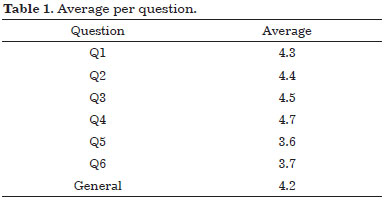
Regarding the SF-36 questionnaire, in question 2, patients rated their overall health now a little better than a year ago (average = 2.2). In question 5b, they did not perform fewer tasks than they would like in relation to work or other daily activity due to emotional problems (average = 1.8). In question 7, they reported mild pain during the last month (average = 2.6). In question 9a, they replied that, during the past month, most of the time they felt invigorated, full of energy and strength (average = 2.4). In question 9d, they report that, during the past month, most of the time they felt easy and relaxed (average = 2.8). In question 11d, they consider their health to be excellent (average = 1.8).
In a correlation between questionnaires ROE and SF36, significant results were obtained for the following questions:
Question 2 of the SF 36 questionnaire (Compared to what it was one year ago, how would you consider your overall health now?) was significant for question 4 of the ROE questionnaire (Do you think the current appearance of your nose hinders your social or professional activities?) (p = 0.026) (Table 2).
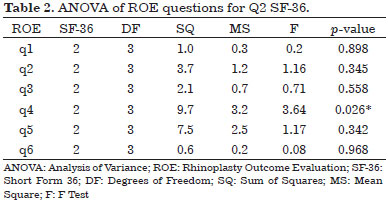
Question 5b of the SF 36 questionnaire (During the past 4 weeks, did you carry out fewer tasks than you would like because of some emotional problem?) was significant for question 5 of the ROE questionnaire (Do you think that the appearance of your nose is the best it could be?) (p = 0.011) (Table 3).
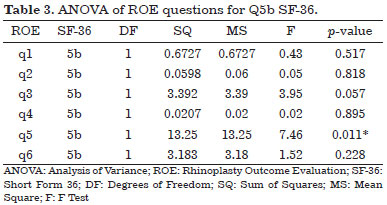
Question 7 of the SF 36 questionnaire (How much pain were you in during the past 4 weeks?) was significant for question 1 of the ROE questionnaire (Do you like how your nose looks?) (p = 0.007) (Table 4).
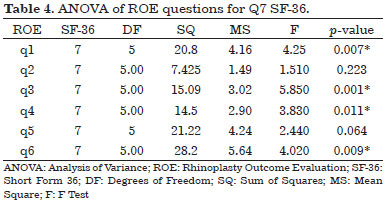
Question 9a of the SF 36 questionnaire (How much have you felt invigorated, full of desire and strength during the past 4 weeks?) was significant for question 1 of the ROE questionnaire (Do you like how your nose looks?) (p = 0.001) (Table 5).
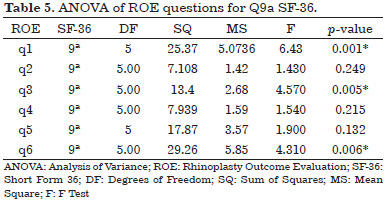
Question 9d of the SF 36 questionnaire (How much have you felt easy and relaxed during the past 4 weeks?) was significant for question 4 of the ROE questionnaire (Do you think that the current appearance of your nose hinders your social or professional activities?) (p = 0.021) (Table 6).
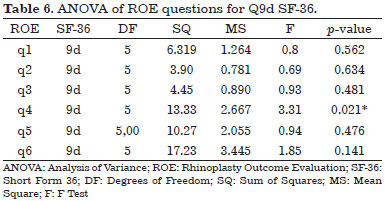
Question 11d of the SF 36 questionnaire (My health is excellent) was significant for question 3 of the ROE questionnaire (Do you think your friends and loved ones like your nose?) (p = 0.027) (Table 7).
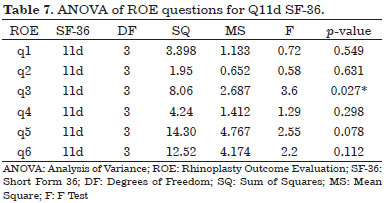
DISCUSSION
We observed that patients responding the ROE questionnaire are mostly satisfied with nose appearance and functionality in postoperative aesthetic rhinoplasty, but believe they can improve even more, and some would undergo a new surgery to achieve greater satisfaction.
In the SF-36 questionnaire, the average of all answers show that most patients consider they have high quality of life.
Correlating the two questionnaires, patients who rated their overall health as best when compared to a year ago showed that the current appearance of their nose rarely or never hinders their social or professional activities. Patients who do not cease to carry out daily tasks because of emotional problems consider the appearance of their nose to be as good as it could be.
Patients who felt no pain, very mild or mild pain during the past month, as well as patients who have mostly felt invigorated, full of desire and strength, have experienced better quality of life as a consequence of that and are more satisfied with the current appearance of their nose.
Patients who reported feeling easy or relaxed most of the time in the past 4 weeks consider that the current appearance of their nose rarely disrupts their social or professional activities.
And finally, patients who consider their health to be excellent mostly believe that their friends and loved ones like the appearance of their nose.
Patients submitted to the SF-36 and ROE questionnaires have a high degree of postoperative satisfaction and believe they have good quality of life. After analyzing the data, we concluded that quality of life is related to the level of satisfaction in postoperative aesthetic rhinoplasty in some of the items observed in the questionnaires.
COLLABORATIONS
MT Analysis and/or interpretation of data; final approval of the manuscript; conception and design of the study; completion of surgeries and/or experiments; writing the manuscript or critical review of its contents.
IG Analysis and/or interpretation of data; final approval of the manuscript; conception and design of the study; completion of surgeries and/or experiments; writing the manuscript or critical review of its contents.
KBM Analysis and/or interpretation of data; statistical analyses; conception and design of the study; completion of surgeries and/or experiments; writing the manuscript or critical review of its contents.
MLSA Analysis and/or interpretation of data; statistical analyses; conception and design of the study; completion of surgeries and/or experiments; writing the manuscript or critical review of its contents.
JOGF Analysis and/or interpretation of data; final approval of the manuscript; conception and design of the study; writing the manuscript or critical review of its contents.
REFERENCES
1. Ching S, Thoma A, McCabe RE, Antony MM. Measuring outcomes in aesthetic surgery: a comprehensive review of the literature. Plast Reconstr Surg. 2003;111(1):469-80. DOI: http://dx.doi.org/10.1097/00006534-200301000-00085
2. Kosowski TR, McCarthy C, Reavey PL, Scott AM, Wilkins EG, Cano SJ, et al. A systematic review of patient-reported outcome measures after facial cosmetic surgery and/or nonsurgical facial rejuvenation. Plast Reconstr Surg. 2009;123(6):1819-27. PMID: 19483584 DOI: http://dx.doi.org/10.1097/PRS.0b013e3181a3f361
3. Alsarraf R. Outcomes research in facial plastic surgery: a review and new directions. Aesthetic Plast Surg. 2000;24(3):192-7. DOI: http://dx.doi.org/10.1007/s002660010031
4. Pereira Filho GA, Valiati AA, Schilling Minuzzi AC, Cunha TF, Pires JA, Garcia AC, et al. Assessment of long-term patient satisfaction after rhinoplasty performed at the Plastic Surgery Department of Santa Casa de Misericórdia de Porto Alegre. Rev Bras Cir Plást. 2011;26(4):618-23.
5. Guillemin F, Bombardier C, Beaton D. Cross-cultural adaptation of health-related quality of life measures: literature review and proposed guidelines. J Clin Epidemiol. 1993;46(12):1417-32. PMID: 8263569 DOI: http://dx.doi.org/10.1016/0895-4356(93)90142-N
1. Hospital Ipiranga, São Paulo, SP, Brazil
2. Universidade Anhembi Morumbi, São Paulo, SP, Brazil
3. Universidade Federal de São Paulo, São Paulo, SP, Brazil
4. Sociedade Brasileira de Cirurgia Plástica, São Paulo, SP, Brazil
Institution: Hospital Ipiranga, São Paulo, SP, Brazil.
Corresponding author:
Massaki Tani
Rua Tobias Monteiro, 119
São Paulo, SP, Brazil Zip Code 04355-010
E-mail: massakitani@yahoo.com.br
Article received: June 26, 2016.
Article accepted: February 3, 2017.
Conflicts of interest: none.


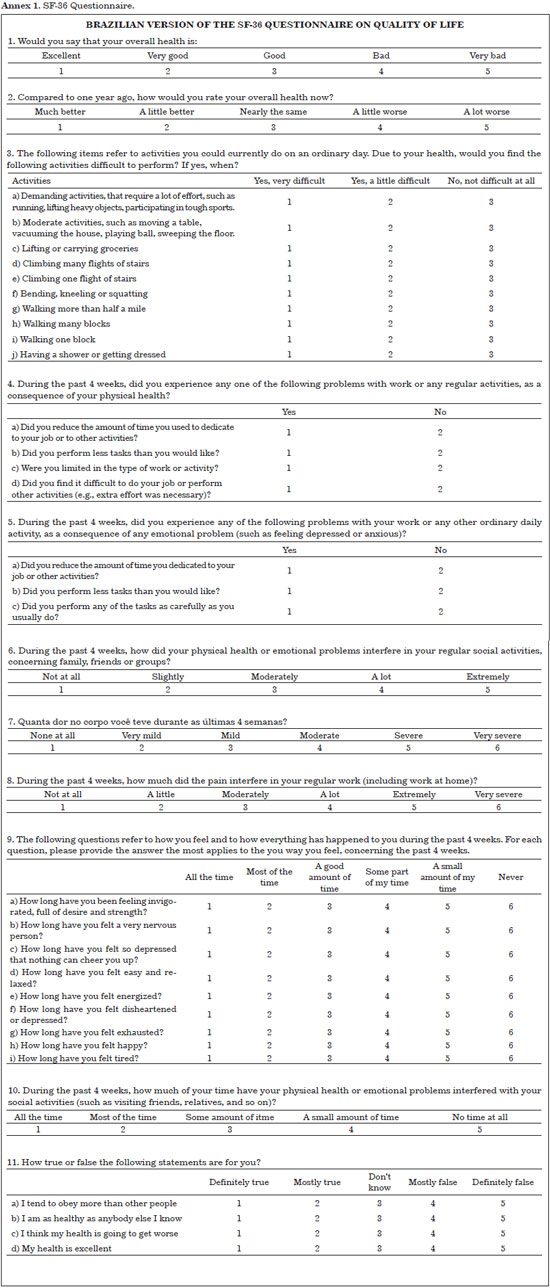
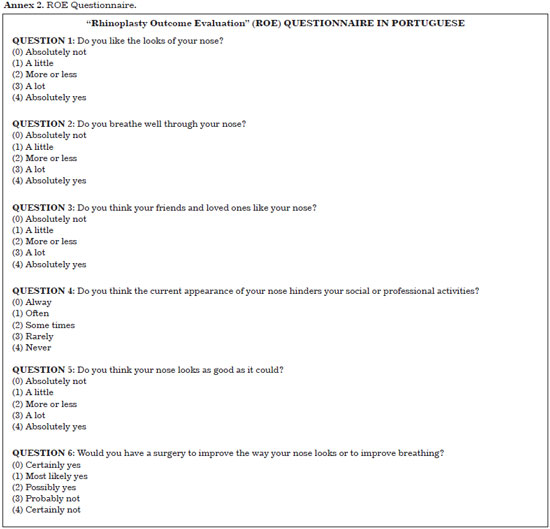
 Read in Portuguese
Read in Portuguese
 Read in English
Read in English
 PDF PT
PDF PT
 Print
Print
 Send this article by email
Send this article by email
 How to Cite
How to Cite
 Mendeley
Mendeley
 Pocket
Pocket
 Twitter
Twitter